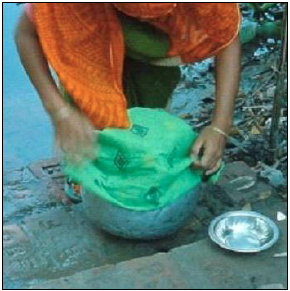Difference between revisions of "Straining (fabric or micro)"
| Line 2: | Line 2: | ||
[[Image:straining icon.png|right]] | [[Image:straining icon.png|right]] | ||
[[Image:straining with cloth.jpg|thumb|right|250px|A woman uses a sari cloth to strain water. Photo: CAWST.]] | [[Image:straining with cloth.jpg|thumb|right|250px|A woman uses a sari cloth to strain water. Photo: CAWST.]] | ||
| + | Straining water through a cloth has been widely used for household water treatment in many cultures for centuries. A common sari cloth is usually used for this in South Asia, for example (photo on right). | ||
Straining through a fine cloth can take out guinea-worm, organic matter, and help clear up turbidity. | Straining through a fine cloth can take out guinea-worm, organic matter, and help clear up turbidity. | ||
| + | |||
| + | The pore size range in old (laundered) sari cloth is 100–150 μm, but about 20 μm if the cloth is folded four to eight times. The holes allow water to pass but retain particles and pathogens >20 μm. Straining through sari cloth has been shown to be effective in filtering out the plankton to which cholera bacteria may attach themselves, therefore reducing the risk of cholera. This simple method can also filter out many helminths and their eggs and larvae. | ||
| + | |||
| + | Old sari cloth made of cotton was found to be most effective in removing cholera based on laboratory experiments. After several launderings, threads of an old sari become soft and loose, reducing the pore size, compared with new sari cloth. | ||
| + | |||
| + | ==Construction, operations and maintenance== | ||
| + | Fold a large, clean piece of cloth seven to eight times. Place the folded cloth over a clean water container, and secure in place. Pour water through the cloth into the container. Wash the cloth in clean water before using it again. | ||
==Reference manuals, videos, and links== | ==Reference manuals, videos, and links== | ||
Revision as of 00:00, 4 July 2012
| |
Straining water through a cloth has been widely used for household water treatment in many cultures for centuries. A common sari cloth is usually used for this in South Asia, for example (photo on right).
Straining through a fine cloth can take out guinea-worm, organic matter, and help clear up turbidity.
The pore size range in old (laundered) sari cloth is 100–150 μm, but about 20 μm if the cloth is folded four to eight times. The holes allow water to pass but retain particles and pathogens >20 μm. Straining through sari cloth has been shown to be effective in filtering out the plankton to which cholera bacteria may attach themselves, therefore reducing the risk of cholera. This simple method can also filter out many helminths and their eggs and larvae.
Old sari cloth made of cotton was found to be most effective in removing cholera based on laboratory experiments. After several launderings, threads of an old sari become soft and loose, reducing the pore size, compared with new sari cloth.
Construction, operations and maintenance
Fold a large, clean piece of cloth seven to eight times. Place the folded cloth over a clean water container, and secure in place. Pour water through the cloth into the container. Wash the cloth in clean water before using it again.
Reference manuals, videos, and links
- Manual that includes micro-filtration: MCALLISTER, SKYE. EPD 397 TECHNICAL REPORT ANALYSIS AND COMPARISON OF SUSTAINABLE WATER FILTERS. May 2005.
Acknowledgements
- Brikke, François, and Bredero, Maarten. Linking technology choice with operation and maintenance in the context of community water supply and sanitation: A reference document for planners and project staff. World Health Organization and IRC Water and Sanitation Centre. Geneva, Switzerland 2003.

